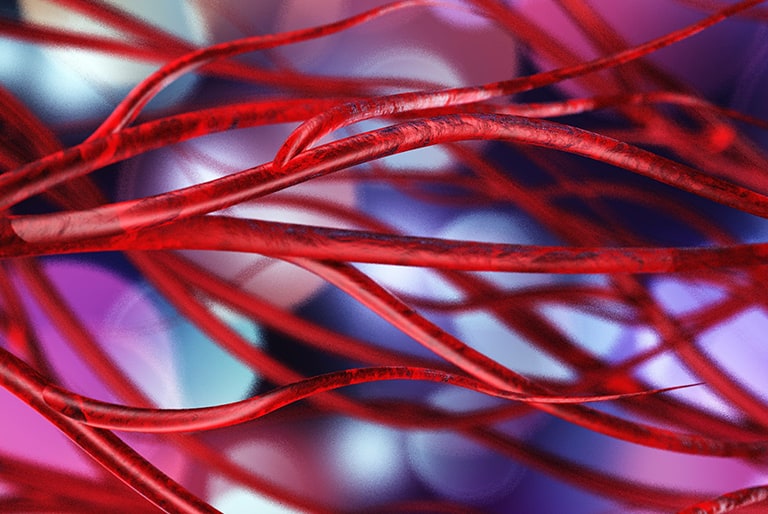The venous system
How is the venous system structured and how exactly do our veins work? Here you will find an overview of the structure of the leg veins and learn why movement is so important for vein health.
How is the venous system in your legs structured?

The job of your leg veins is to transport the oxygen-poor blood back to your heart and lungs. This requires a great deal of heavy work from the veins, as they have to convey the blood upwards against gravity. The venous system in your legs can be sub-divided into two systems, which both consist of different types of vein and which are interlinked.
- Superficial veins: the superficial veins lie in the skin and the tissue directly beneath the skin. On many people, they are visible from outside through the skin. The superficial venous system comprises many small, branched veins, which transport the blood from the skin and the subcutaneous fat tissue to the superficial trunk veins. There are two of them in each leg: the great and the short saphenous vein. The small saphenous vein (vena saphena parva) runs from the outside ankle along the calf up to the hollow of the knee, where it empties into the deep veins. The great saphenous vein (vena saphena magna) starts on the inside of the ankle and runs along the whole length of the leg up to the groin, where it empties into the thigh vein.
- Deep veins: the veins in the deep venous system are not visible from outside and are deeply embedded in the muscles. The deep veins run parallel to the arteries, which transport oxygen-rich blood into the smallest blood vessels. The deep veins in the lower leg run below the knee joint to the thigh vein (vena femoralis), which then becomes the external iliac vein which transmits the blood collected from the leg veins towards the heart.
- Connecting veins: the deep and superficial veins are connected to one another by the really short perforator veins, which perforate the connective tissue and the muscles and thus facilitate the transportation of blood.
Under normal circumstances, the venous system operates like a huge network of one-way streets. This is because in healthy people, the blood flow from the legs always goes in one direction: upwards towards the heart.
What is the job of venous valves?
The venous valves come into play in order to prevent the back-flow of blood, which would normally happen due to the laws of gravity. These venous valves are sail-like protrusions of the vein walls, which are to be found at regular intervals in all large veins. As soon as the blood has been pumped upwards, the venous valves close the larger leg veins like a non-return valve and do not let any fluid flow back down.If the venous valves do not close sufficiently or if their functionality is weakened, the blood flows back and the legs swell up. Many venous diseases experience such a functional disorder of the venous valves. As an advanced course of vein weakness the build-up of blood in the legs can cause varicose veins and even vein thrombosis.
How does the venous pump work?
Every day, the veins of an adult human have to convey between 7,000 and 10,000 litres of blood through the body. In order to be able to press the blood upwards out of the feet in the first place, the venous pump, or muscle pump as it is also known, has to work really hard. It works like this:
- Movement causes the muscles to contract and then to loosen into a relaxed state. This exchange between contraction and relaxation starts the venous pump.
- When the muscle is tensed, the walls of the vein are pressed together and the blood is pushed upwards.
- When the muscle relaxes, the veins open up again. That creates suction, which in turns pulls in blood from the smaller veins of the superficial venous system and presses it upwards at the next muscle contraction.
Movement is therefore the best therapy for healthy, functional veins. Anyone who moves a lot does his veins a big favour and keeps the blood flow going. It is quite a different story when seated or standing: when the muscles are in a relaxed state, blood collects quickly in the lower extremities.
How can I activate the venous pump?
Swollen, heavy legs do not have to be, because movement alone is usually enough to dissolve the build-up of blood. Here are a few tips on how you can get your venous pump going in everyday life:
- Take a stroll, every single day
- Walk up stairs, because that puts calf muscles under stress
- Foot gymnastics such as walking on the spot, stretching and curling your feet, rocking on your tiptoes
- Contrast showers with cold and hot water
You can also give your veins relief when you are resting, by putting your feet up. The blood can flow more easily out of your legs if your feet are higher than your hips.Other ways to also support your veins: drink enough every day, preferably water or unsweetened tea, so that your blood can always flow easily. Medicines such as Veno SL® 300 can also help to improve your blood fluidity and to stabilise your fine blood vessels. In any case, you should start thinking about your veins after the age of 30 and help them with their tough job of transporting blood against gravity, so that your blood vessels do not weaken too soon and they remain efficient into old age.